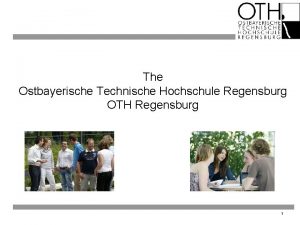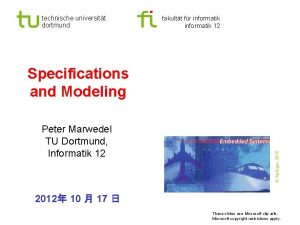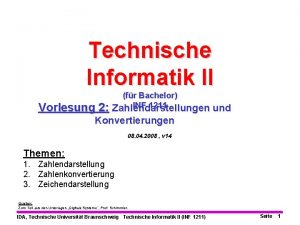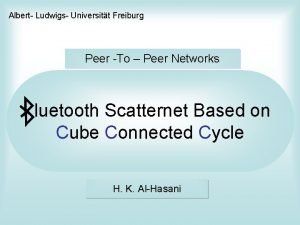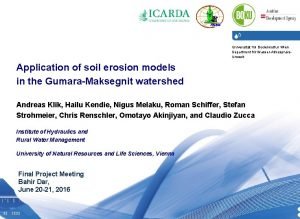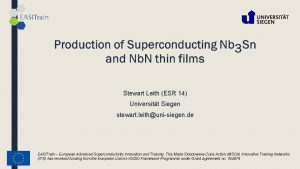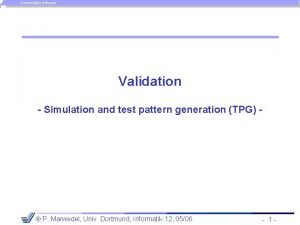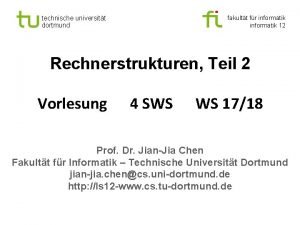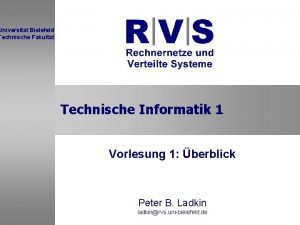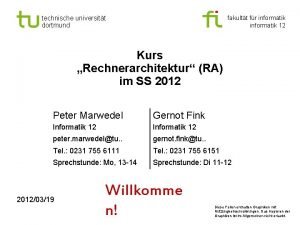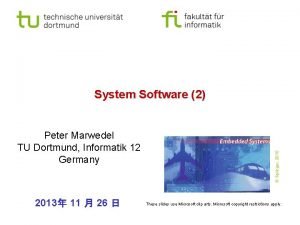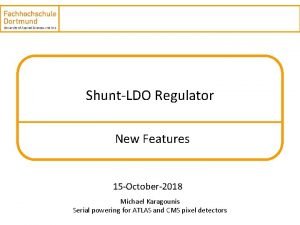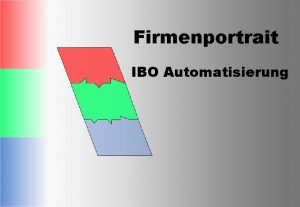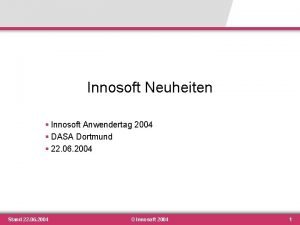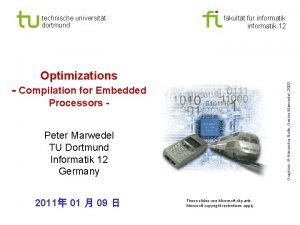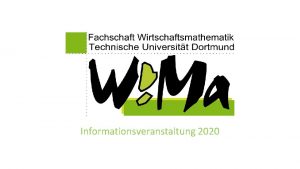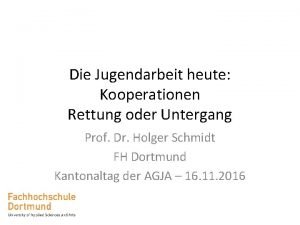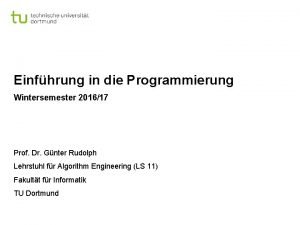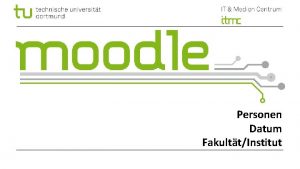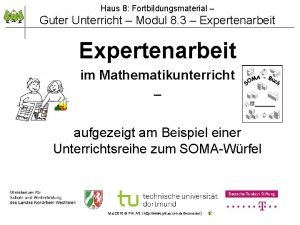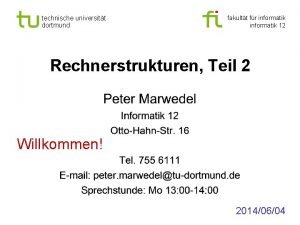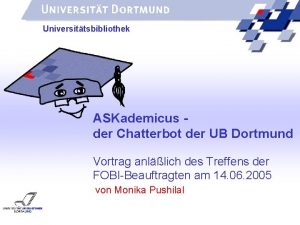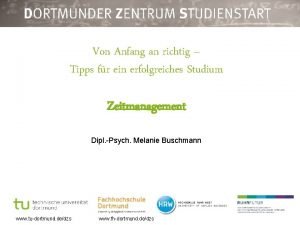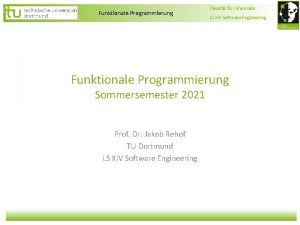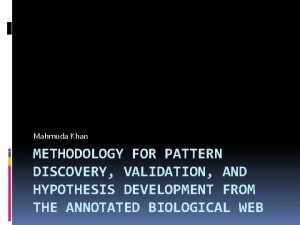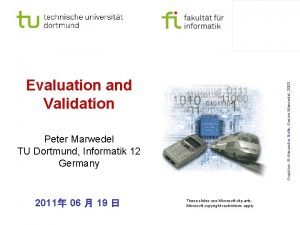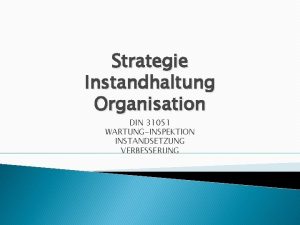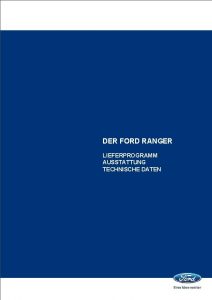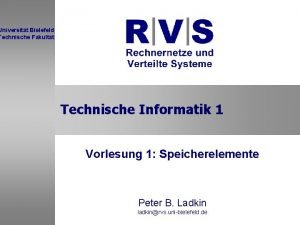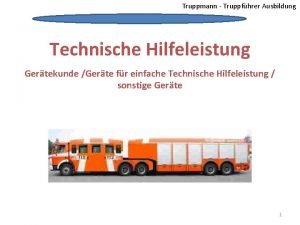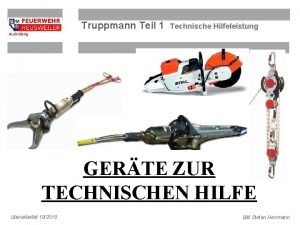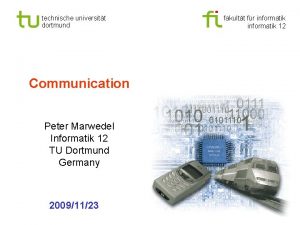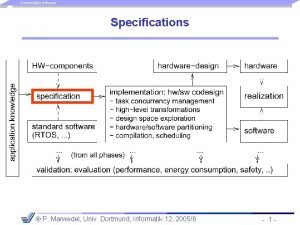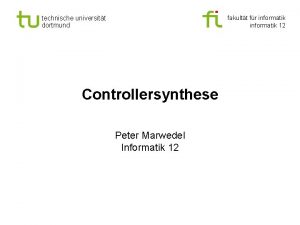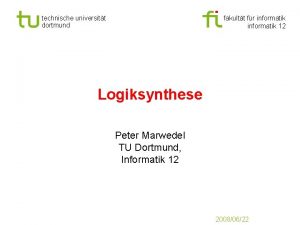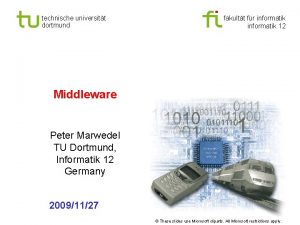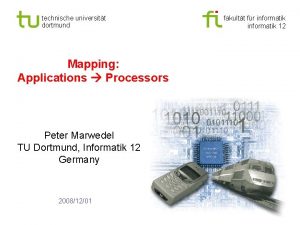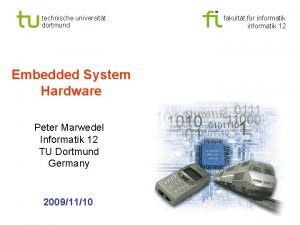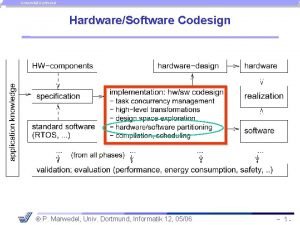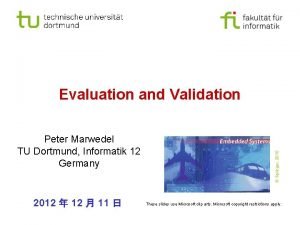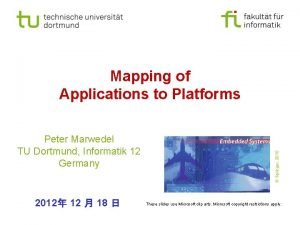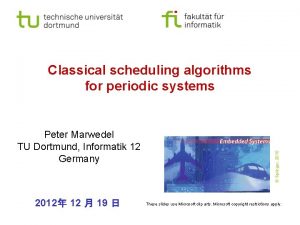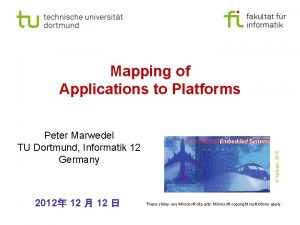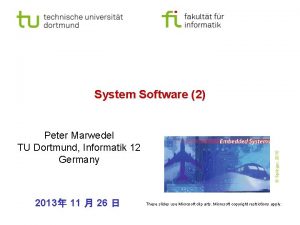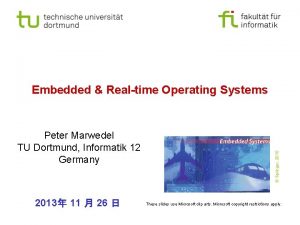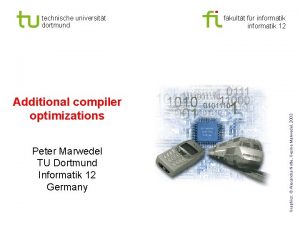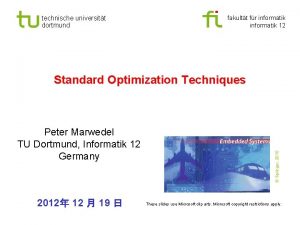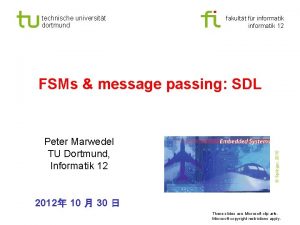technische universitt dortmund Applications 2 Peter Marwedel Informatik


















![Vendors other than Xilinx? PLD=FPGA+CPLD Sales 2002 Rank Company Sales (M$) Share [%] FPGA-Share Vendors other than Xilinx? PLD=FPGA+CPLD Sales 2002 Rank Company Sales (M$) Share [%] FPGA-Share](https://slidetodoc.com/presentation_image_h2/bcf930d19ff695b719d94429bfc95cc1/image-19.jpg)











![Steps used in the Agility compiler [© Celoxica] technische universität dortmund fakultät für informatik Steps used in the Agility compiler [© Celoxica] technische universität dortmund fakultät für informatik](https://slidetodoc.com/presentation_image_h2/bcf930d19ff695b719d94429bfc95cc1/image-31.jpg)









- Slides: 40

technische universität dortmund Applications (2) Peter Marwedel Informatik 12, TU Dortmund fakultät für informatik 12

Gliederung Zeitplan § Einführung § System. C § Vorlesungen und Programmierung § FPGAs - Vorlesungen - VHDL-basierte Konfiguration von FPGAs mit dem XUP VII Pro Entwicklungssystem § Algorithmen - Mikroarchitektur-Synthese - Automatensynthese - Logiksynthese - Layoutsynthese technische universität dortmund fakultät für informatik p. marwedel, informatik 12, 2008 3, 5 Wochen 6 Wochen - 2 -

Typical applications § § § § Diploma theses @ Dortmund: real-time computations Graphics accelerators Encryption/decryption Bio-sequence database scanning Network applications (e. g. network intrusion detection) Parallel pattern recognition in physics Emulation (of new hardware processors) technische universität dortmund fakultät für informatik p. marwedel, informatik 12, 2008 - 3 -

Survey: Use of FPGAs in Bioinformatics § Bioinformatics applications: – little I/O – dynamic programming – big lookup tables § Ideal for FPGA § Currently one company (Time. Logic) sells FPGA cards for BLAST and Smith. Waterman § Cost: ~$20, 000 for cards § Used routinely in biotech / pharma companies technische universität dortmund fakultät für informatik p. marwedel, informatik 12, 2008 - 4 -

Source: courses. ece. uiuc. edu/ece 412/lectures/lecture 17. ppt Mid-Grain: Amalgam technische universität dortmund fakultät für informatik p. marwedel, informatik 12, 2008 - 5 -

Amalgam Performance 24 24 22 22 N-Queens 2 D IDCT Rijndael Encryption Image Dithering DNA Pattern Match 20 18 16 16 14 14 12 12 10 10 8 8 6 6 4 4 2 2 0 1 2 3 4 5 6 7 8 0 Number of Clusters technische universität dortmund fakultät für informatik p. marwedel, informatik 12, 2008 - 6 -

Bioinformatics 1: Sequence Alignment • The genome, and the proteins, are very complex and difficult to decipher: • A genome is a string of DNA bases, A, C, G or T; from ½ million (mycoplasma) to 10 billon (lilly). • The genome is interpreted by working out which regions of the DNA code for protein, and what the likely function of these proteins is. • We currently do this by matching sequences to those of DNA or proteins used in previous experiments. • A priori prediction of structure/function still a distant dream. technische universität dortmund fakultät für informatik Simplified diagram of the smallest genome known, Mycoplasma pneumoniae p. marwedel, informatik 12, 2008 - 7 -

Bioinformatics 2: Reconstruction of regulatory networks § An emerging field § Attempts to model the complex interactions between DNA and the protein it encodes, that ultimately control the processes of life. § Often uses analogies to circuitry. However biological data is always incomplete, sometimes very sparse. § SANs, Petri. Nets, locally Mobius utilized. technische universität dortmund fakultät für informatik p. marwedel, informatik 12, 2008 - 8 -

Typical applications § Diploma theses @ Dortmund: real-time computations § Graphics accelerators § Encryption/decryption § Bio-sequence database scanning § Network applications (e. g. network intrusion detection) § Parallel pattern recognition in physics § Emulation (of new hardware processors) technische universität dortmund fakultät für informatik p. marwedel, informatik 12, 2008 - 9 -

High Energy Physics BTe. V Experiment Fermi. Lab Accelerator Source: http: //false 2002. vander bilt. edu/talks/Bapty. ppt technische universität dortmund fakultät für informatik p. marwedel, informatik 12, 2008 - 10 -

Particle Measurement Toroid p Muon Magnet RICH Cal Absorber Dipole 12 m EM Hadron p ± 300 mrad 0 Forward tracker provides: • Momentum measurement • Pattern recognition for tracks born in decays downstream of vertex detector • Projection of tracks into particle ID devices Detector Grids Problem: -Massive amounts of data (Terabytes/Sec) -Determine the set of particle trajectories -Decide if it is interesting, keep or toss -Hardware => 2500 DSP’s + 2500 PC’s -Never Fail (ok to degrade) technische universität dortmund fakultät für informatik p. marwedel, informatik 12, 2008 - 11 -

Trigger System (20, 000 ft. view) Memory Queue, ~ms Pre. Proces s (FPGA) technische universität dortmund fakultät für informatik 1 st Level (DSP) 2 nd Level (PC) ~2000 Nodes p. marwedel, informatik 12, 2008 Store - 12 -

Typical applications § Fast Object recognition • Medical, security, … • Military § Graphics accelerators § Encryption/decryption § Bio-sequence database scanning § Network applications (e. g. network intrusion detection) § Parallel pattern recognition in physics § Emulation (of new hardware processors) technische universität dortmund fakultät für informatik p. marwedel, informatik 12, 2008 - 13 -

Source: http: //bwrc. eecs. berkeley. edu/Presentations/Retreats/ technische universität Winter_Retreat_2004/Monday%20 PM/Wawrzynekdortmund HERC_BEE 2 v 1. ppt fakultät für informatik 12 High-End Reconfigurable Computing Berkeley Wireless Research Center January 2004 John Wawrzynek, Robert W. Brodersen, Chen Chang, Vason Srini, Brian Richards January 12, 2004 BWRC, UC Berkeley 14

Berkeley Emulation Engine § FPGA-based system for real-time hardware emulation: • • • Emulation speeds up to 60 MHz Emulation capacity of 10 Million ASIC gateequivalents, corresponding to 600 Gops (16 -bit adds) (although not a logic gate emulator. ) 2400 external parallel I/Os providing 192 Gbps raw bandwidth. technische universität dortmund fakultät für informatik p. marwedel, informatik 12, 2008 - 15 -

Status § Four BEE processing units built § Three in continuous “production” use § Supported universities CMU, USC, Tampere, UMass, Stanford § Successful tapeout of: § 3. 2 M transistor pico-radio chip § 1. 8 M transistor LDPC decoder chip § System emulated: § QPSK radio transceiver § BCJR decoder § MPEG IDCT § On-going projects § UWB mix-signal SOC § MPEG transcoder § Pico radio multi-node system § Infineon SIMD processor for SDR § technische universität dortmund fakultät für informatik p. marwedel, informatik 12, 2008 - 16 -

Lessons from BEE § Simulink based tool-flow very effective FPGA programming model in DSP domain. § Many system emulation tasks are significant computations in their own right – highperformance emulation hardware makes for highperformance general computing. § Is this the right way to build supercomputers? § BEE could be scaled up with latest FPGAs and by using multiple boards Tera. BEE (B 2). technische universität dortmund fakultät für informatik p. marwedel, informatik 12, 2008 - 17 -

Is Reconfigurable Going Mainstream? § Cray XD 1: – 12 Opterons per chassis – 6 Xilinx Virtex Pro 50 FPGAs – Communication network/processor § SGI Altix 350: – 1 -32 Itanium 2 s – 1 Xilinx XCV 6000 per processor pair – Fast interconnect technology § SRC: – Pentium 4 Xeons – MAPs: multiple XCV 6000 FPGAs – X-bar § Time. Logic, Starbridge, others… § NCSA is exploring this technology. technische universität dortmund fakultät für informatik p. marwedel, informatik 12, 2008 - 18 -
![Vendors other than Xilinx PLDFPGACPLD Sales 2002 Rank Company Sales M Share FPGAShare Vendors other than Xilinx? PLD=FPGA+CPLD Sales 2002 Rank Company Sales (M$) Share [%] FPGA-Share](https://slidetodoc.com/presentation_image_h2/bcf930d19ff695b719d94429bfc95cc1/image-19.jpg)
Vendors other than Xilinx? PLD=FPGA+CPLD Sales 2002 Rank Company Sales (M$) Share [%] FPGA-Share 2004* [%] 1 Xilinx 1, 125 49 ~55 2 Altera 712 31 ~30 3 Lattice 235 10 4 Actel 135 6 5 Cypress ? ? 2 6 Quicklogic 33 1 7 Atmel 25 Source: *: Altera (http: //biz. yahoo. com/e/050311/altr 10 -k. html), other numbers from IC Insights technische universität dortmund fakultät für informatik p. marwedel, informatik 12, 2008 - 19 -

Altera support tools Anwendung: Video-Dekodierung http: //www. altera. com/technology/dsp/devices/fp ga/dsp-fpga_coprocessor. html technische universität dortmund fakultät für informatik p. marwedel, informatik 12, 2008 - 20 -

technische universität dortmund fakultät für informatik 12 Stile der FPGA-Synthese Peter Marwedel TU Dortmund, Informatik 12 Germany

Synthese Def. : Synthese ist das Zusammensetzen von Komponenten oder Teilen einer niedrigen (Modell-) Ebene zu einem Ganzen mit dem Ziel, ein auf einer höheren Ebene beschriebenes Verhalten zu erzielen. [Advanced Learners Dictionary of Contemporary English]. Spezifikation Implementierung technische universität dortmund fakultät für informatik p. marwedel, informatik 12, 2008 - 22 -

„correctness by construction“ Sofern Synthesemethoden garantiert korrekte Entwürfe erstellen, brauchen diese nicht mehr per Simulation überprüft zu werden. Die Korrektheit der Methoden ist allerdings bisher nur in wenigen Fällen nachgewiesen worden. Simulationen sind daher weiterhin sinnvoll, aber weniger wichtig. Ideal: für alle Entwurfsaufgaben gute Syntheseverfahren. technische universität dortmund fakultät für informatik p. marwedel, informatik 12, 2008 - 23 -

Ideal und Wirklichkeit Für alle Entwurfsaufgaben gute Synthese: kaum erreichbar. Nach H. de Man liegt ist dies prinzipiell begründet: § EDA-Hersteller mit der Pflege vorhandener Software beschäftigt. § Anwender wollen aufgrund der für Wartung aufzuwendenden Kosten keine Werkzeuge selbst entwickeln und pflegen. § Forschungsinstitute müssen Probleme erfahren, Lösungen erarbeiten & mit EDA-Firmen in Produkte umsetzen. Dissertationen: ca. 5 Jahre vom Auftauchen des Problems bis zur breiten Markteinführung knapp 10 Jahre. de Man: tomorrow's tools solve yesterday's problems. Termingerechter Entwurf ohne Synthese nicht möglich. technische universität dortmund fakultät für informatik p. marwedel, informatik 12, 2008 - 24 -

Formen der Synthese Unterschiedliche Ziele und Quellen; mögliche Darstellung: Algorithmus, “behavioral” (untimed) Algorithmus, “behavioral” (timed) RT-Verhalten XST Catapult Celoxica, u. a. RT-Struktur-Ebene Gatter Layout technische universität dortmund fakultät für informatik p. marwedel, informatik 12, 2008 - 25 -

Nachteile einer Spezifikation auf RT-Ebene Nachteile einer Spezifikation wie bei XST § Man gibt die Schaltungsblöcke bereits vor. § Man muss sich überlegen, was in welchem Taktzyklus stattfindet. § Die Vorteile von VHDL, Algorithmen beschreiben zu können, werden kaum genutzt. § Liegt die ursprüngliche Spezifikation on C oder System. C vor, so muss die VHDL-Beschreibung manuell neu erstellt werden. • Es können sich viele Fehler einschleichen. • Der Aufwand ist enorm. technische universität dortmund fakultät für informatik p. marwedel, informatik 12, 2008 - 26 -

Synthese von „timed behavioral descriptions“ §… § Co-Centric § Celoxica: DK design suite (Handel-C), Agility (System. C) technische universität dortmund fakultät für informatik p. marwedel, informatik 12, 2008 - 27 -

System. C Synthese Ablauf 1. 2. 3. 4. Produce a simulation model of your design in System. C/C++. Produce a testbench (also in System. C/C++). Simulate and test the model. Refine the simulation design into synthesizable code. Carry this out manually. Good practice to split your design into header (. h) files and the corresponding implementations in. cpp files for easier recompilation. 5. Compile your design into RTL System. C using Agility. 6. Test the synthesizable model. 7. Compile your design into HDL (EDIF, Verilog or VHDL) using Agility. Different synthesis flags and optimizations available. 8. Examine the synthesis reports. 9. If constraints not met: refine your design and repeat. 10. Once requirements are met, run Place and Route tools. [Celoxica: Agility Compiler manual, v 1. 1, 2006] technische universität dortmund fakultät für informatik p. marwedel, informatik 12, 2008 - 28 -

Agility code requirements The source code and header files include: § header files appropriate for simulation or synthesis (as specified in a preprocessor directive) § an ag_main function, used for synthesis, comprising an instantiation of a top-level module and any user constraints § an sc_main function, called for simulation, and comprising an instantiation of a top-level module & user constraints § a top-level module, instantiating modules to be synthesized § modules, threads, methods describing the logic of your design § Signals, FIFOs, channels describing communication [© Celoxica] technische universität dortmund fakultät für informatik p. marwedel, informatik 12, 2008 - 29 -

Supported types Type Available for compiletime evaluation Available for synthesis char ok ok ok no bool ok ok Pointers ok If compile-time resolvable References ok If compile-time resolvable Unions no no Bit fields no no Arrays ok Depends on contents Structs ok Depends on contents sc_ufixed no no sc_int, sc_uint sc_bigint, sc_biguint, sc_fixed ok ok short int long int float double long double technische universität dortmund fakultät für informatik p. marwedel, informatik 12, 2008 - 30 -
![Steps used in the Agility compiler Celoxica technische universität dortmund fakultät für informatik Steps used in the Agility compiler [© Celoxica] technische universität dortmund fakultät für informatik](https://slidetodoc.com/presentation_image_h2/bcf930d19ff695b719d94429bfc95cc1/image-31.jpg)
Steps used in the Agility compiler [© Celoxica] technische universität dortmund fakultät für informatik p. marwedel, informatik 12, 2008 - 31 -

Compile-time evaluation Agility unrolls loops, resolves pointers, inlines functions, evaluates values of variables known at compile-time. § Loop unrolling Loop unroller unrolls loops that must be unrolled and skips over those that do not. Any loops without wait() statements unrolled to produce combinational logic. [© Celoxica] technische universität dortmund fakultät für informatik p. marwedel, informatik 12, 2008 - 32 -

Loop unrolling limitations The loop unroller cannot unroll loops containing: § wait statements § loop conditions including unknown variables. Loops containing wait() statements are skipped and the values of variables in their bodies are tagged as unknown. If the condition of a loop that must be unrolled contains a variable with an unknown value, it causes an error. Example int k = 0; for (int i=0; i<10; i++) { k = k + 5; wait(); } for (int j=0; j<k; j++) {. . . code without waits } 1 st loop is skipped due to wait statement k = unknown. 2 nd loop cannot be unrolled. [© Celoxica] technische universität dortmund fakultät für informatik p. marwedel, informatik 12, 2008 - 33 -

Compile-time recursive definitions Synthesis of recursive definitions whose arguments can be determined at compile time. Be sure recursive definitions terminate! Example: Fibonacci function int Fibonacci( int n ) { if (n == 0) // check for termination return 0; if (n == 1) // check for termination return 1; if (n > 1) return ( Fibonacci(n-1) + Fibonacci(n-2) ); } Call to Fibonacci(6) returns 8. technische universität dortmund fakultät für informatik [© Celoxica] p. marwedel, informatik 12, 2008 - 34 -

Function inlining Agility inlines all function definitions. Example: int multiply_and_accumulate(int x, int y, int z) { return (x * y + z); } would be replaced by function body (suitably instantiated). For 2 calls to the function within the same clock cycle, 2 multipliers, 2 adders would be introduced. Effect on the overall circuit size depends on the sharing that Agility may impose. [© Celoxica] technische universität dortmund fakultät für informatik p. marwedel, informatik 12, 2008 - 35 -

Pointer resolution Agility can synthesize pointers that are resolved at compiletime i. e. pointers that are not dynamically changed during the execution of the program. Example: SC_MODULE(My. Module) { Daughter. Module * Daughter. A; . . . SC_CTOR(My. Module) { Daughter. A = new Daughter. Module(); . . . }} technische universität dortmund fakultät für informatik p. marwedel, informatik 12, 2008 [© Celoxica] - 36 -

High-level synthesis: Register inference Registers are inferred from the use of variables. Example: int i = 1, j = 2, k; for (; ; ) {k = i + j; j++; i = k; // Clock cycle 1 wait(); i++; // Clock cycle 2 wait(); } § k only set and read on the same clock cycle and does not persist to another clock cycle: k is a wire. § i is set and read in every clock cycle: i is a register. § j is read in 1 st clock cycle and this value is read in the next execution of the loop: j is a register. [© Celoxica] technische universität dortmund fakultät für informatik p. marwedel, informatik 12, 2008 - 37 -

Fine-grained logic sharing Logic can be shared within a thread if resource constraints exist. Constraints can be defined for: § multipliers, adders, subtractors, relational operators. Agility can share operators when: § Operations in different branches of conditional block § Operations in different clock cycles Example: a = b*c; wait(); d = e*f; wait(); if (Condition) a = b*c; else d = e*f; technische universität dortmund fakultät für informatik p. marwedel, informatik 12, 2008 single multiplier [© Celoxica] - 38 -

Special Case It is not always possible to share entire expressions to produce the minimum hardware. Example: a = (b * c) + d; // multiply followed by add wait(); e = f * (g + h); // add followed by multiply The order of evaluation of the operations is different. If a user placed a constraint of 1 multiplier and 1 adder on this code, Agility could not satisfy these constraints (it does not add the necessary multiplexers and control state logic). Instead, Agility would automatically add an extra resource for an operation. [© Celoxica] technische universität dortmund fakultät für informatik p. marwedel, informatik 12, 2008 - 39 -

Summary Applications (2) § Bio-sequence database scanning § Parallel pattern recognition in physics § Emulation (of new hardware processors) General view on synthesis § Definition of synthesis § Different source and target levels of abstractions § Synthesis from System. C or C slowly becoming available § Restrictions for Celoxica-Agility: • Using timed behaviors … technische universität dortmund fakultät für informatik p. marwedel, informatik 12, 2008 - 40 -
 Oth regensburg exchange
Oth regensburg exchange Rechnerstrukturen tu dortmund
Rechnerstrukturen tu dortmund Technische informatik 2 tu bs
Technische informatik 2 tu bs Ccc freiburg
Ccc freiburg Universitt wien
Universitt wien Universitt
Universitt Harvard universitt
Harvard universitt Dortmund pattern
Dortmund pattern Rechnerstrukturen tu dortmund
Rechnerstrukturen tu dortmund Hazardfehler
Hazardfehler Rechnerarchitektur tu dortmund
Rechnerarchitektur tu dortmund Srp tu dortmund
Srp tu dortmund Michael karagounis
Michael karagounis Ostrzenski dortmund
Ostrzenski dortmund E3t tu dortmund
E3t tu dortmund Referat 7 tu dortmund
Referat 7 tu dortmund Innosoft dortmund
Innosoft dortmund Memory z dortmund
Memory z dortmund Eini tu dortmund
Eini tu dortmund Holger schmidt fh dortmund
Holger schmidt fh dortmund Retina tu dortmund
Retina tu dortmund Wgh dortmund
Wgh dortmund Ews tu dortmund
Ews tu dortmund Pikas uni dortmund
Pikas uni dortmund Studentensekretariat tu dortmund
Studentensekretariat tu dortmund Rechnerstrukturen tu dortmund
Rechnerstrukturen tu dortmund Dortmund lego
Dortmund lego Ub dortmund
Ub dortmund Dortmund arbeitslosenquote
Dortmund arbeitslosenquote Fh dortmund stundenplan erstellen
Fh dortmund stundenplan erstellen Thermico dortmund
Thermico dortmund Funktionale programmierung tu dortmund
Funktionale programmierung tu dortmund Zubair khan dortmund
Zubair khan dortmund Alexandra nolte
Alexandra nolte Verbesserung instandhaltung
Verbesserung instandhaltung Ranger raptor technische daten
Ranger raptor technische daten Omzetsnelheid voorraad berekenen
Omzetsnelheid voorraad berekenen Vorlesung
Vorlesung Zweiarmiger hebel
Zweiarmiger hebel Rettungsgrundsatz technische hilfeleistung
Rettungsgrundsatz technische hilfeleistung Technische voorraad berekenen
Technische voorraad berekenen
